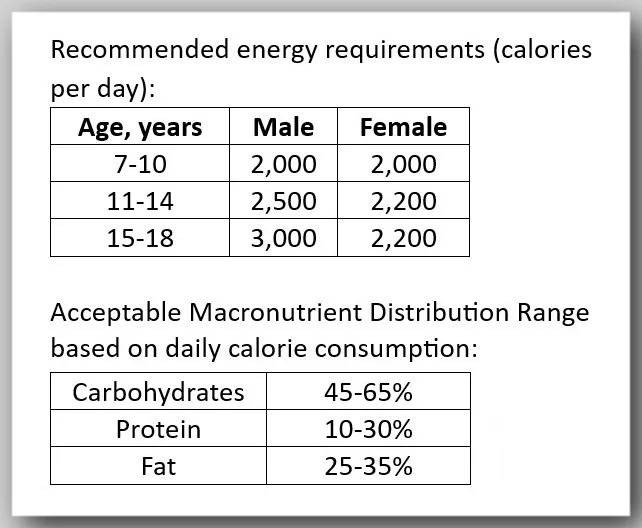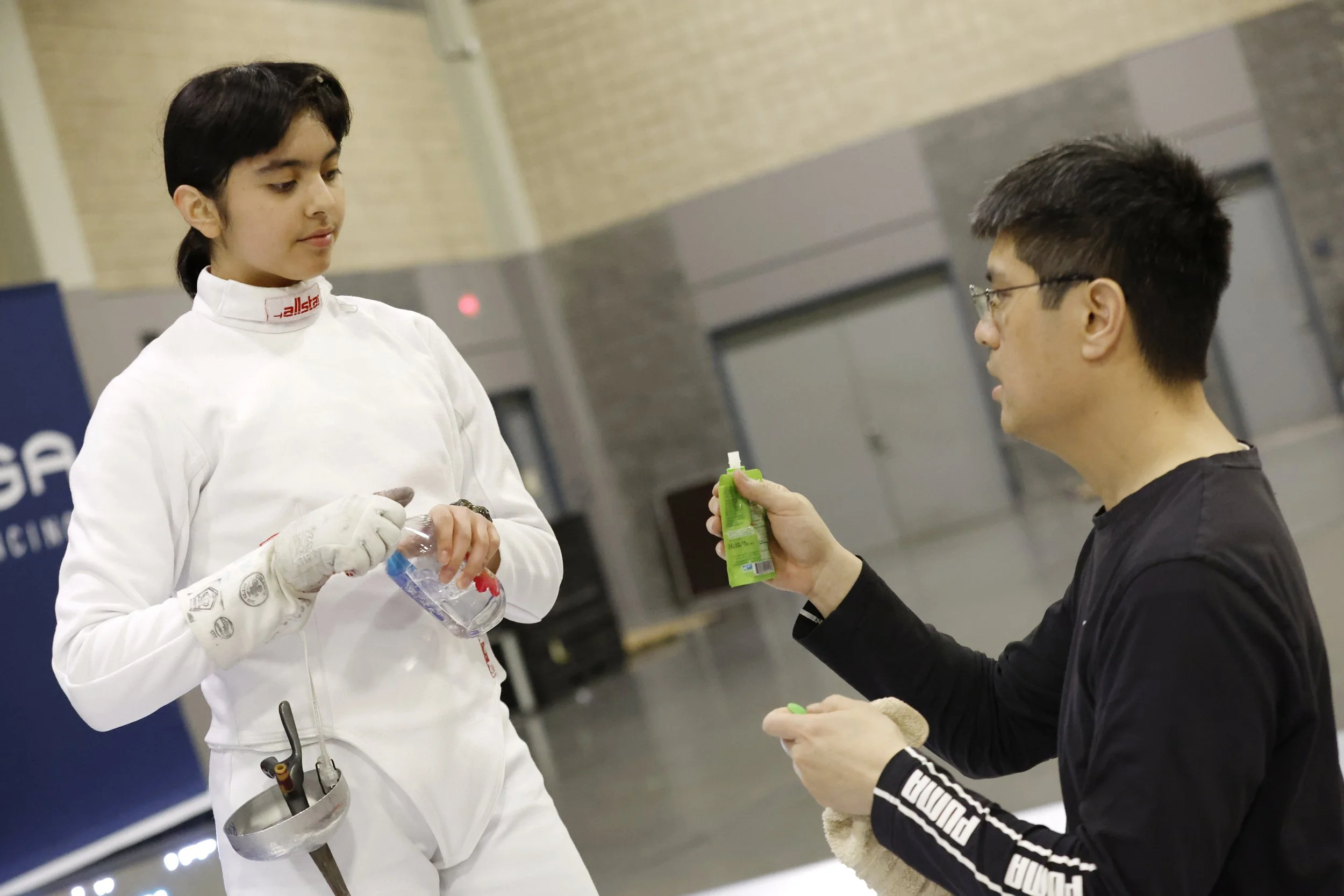Nutrition at the NAC
Nutrition: The often-forgotten component of a well-prepared athlete. How important is nutrition to your performance as an athlete? Research shows poor nutrition can result in decreased energy levels, impaired muscle function, reduced endurance, increased injury risk and even delayed recovery. As an athlete, knowledge of proper nutrition and access to nutrient-rich food during competition are keys to success.
General recommendations for adolescents and teens engaging in high-level training and competition.
Although nutrition education can be daunting, understanding the fundamentals can easily help an athlete make good choices when fueling their body. Let’s break down the basics. There are two major classifications: macronutrients, which provide energy and aid in recovery, and micronutrients, which don’t provide energy but play an important role in various physiological functions. The three macronutrients (carbohydrates, proteins and fat) are all required in an athlete’s diet. Unfortunately, diet culture has created many unsubstantiated claims demonizing certain macronutrients. However, it is important to know that as an athlete, all three macronutrients are needed.
How much do we eat? Specific amounts and calories can be individualized to the athlete, but in the table seen here are general recommendations for adolescents and teens engaging in high-level training and competition.
Micronutrients include vitamins and minerals and are both essential in an athlete’s diet. Micronutrient recommendations are important to meet and can be easily achieved by eating a colorful variety of fruits and vegetables, whole grains, lean protein sources, and dairy or dairy alternatives. Specific vitamins and minerals that are important to make sure teens and adolescents consume include but are not limited to calcium, iron, potassium and vitamin D. Below are foods high in these nutrients:
A healthy, balanced diet eaten at the appropriate times of day is key to optimizing your energy and nutrition to stay fit for competition — but that’s not always easy when you’re traveling.
Photo: Serge Timacheff
Calcium: Milk, yogurt, calcium-fortified alternative milk and yogurt, cheese, cooked collard greens, calcium-fortified orange juice
Iron: Meat, poultry, seafood, iron-fortified breads & cereals, legumes, green leafy vegetables, tofu
Potassium: Cooked Swiss chard or spinach, avocado, potato, pumpkin, white beans, cooked Bok choy, legumes
Vitamin D: Fatty fish, cremini mushrooms, vitamin D-fortified milk, milk-alternative or orange juice. Vitamin D can also be obtained through about 15 minutes of sunlight expo
Timing of food consumption can also play a role in an athlete’s performance. This can be tricky with competition schedules, staying in a hotel and limited access to restaurants near event locations. Below are general guidelines for athletes during competition day.
4-6 hours prior to event:
Eat a full meal concentrating on carbohydrates to access as much fuel for the event and protein.
Try to choose foods you are familiar with, low in fat & fiber, and light on spice level to avoid gastrointestinal issues.
If athletes are scheduled to compete in the morning, an adequate dinner the night before, in addition to a light breakfast, is recommended.
30-60 minutes prior to event:
Carbohydrate snacks and hydration can be consumed to regulate hunger and provide fuel.
Examples include granola bar, banana, packaged snacks like pretzels.
Make sure to sip on water or sports drinks that include carbohydrates and electrolytes.
Quick snacks and hydration during one-minute breaks go a long way in keeping your energy up and preventing cramps!
Photo: Serge Timacheff
During your bout:
Have easy access to water and sports drinks. Make sure to drink a combination of both, especially if you are sweating large amounts.
Although hydration is important during your bout, adequate hydration prior to your event is even more important to combat dehydration symptoms.
30-60 minutes after event:
Refueling your body with carbohydrates and including protein to increase tissue repair and recovery are key.
Nut butter & toast, yogurt parfaits, bagel with toppings, protein smoothie are great options.
If you have completed your event for the day, a full meal with adequate carbohydrates, protein and fat are ideal before resting/sleep.
Access to food, especially access to nutrient-dense food, can be a challenge when your competition is out of town. Take advantage of provided meals at hotels, such as breakfast. They usually have great options to eat prior to heading to the event, and some foods can be taken to-go for a pre-bout snack such as fruit or dry cereals.
Concession stands at NACs don’t always offer the most nutritious selections but provide sustenance if you need quick energy on a long day of fencing.
Bringing nonperishable snacks from home requires some planning but can pay off if access to food is scarce or concession stands lack options. Solid nonperishable choices include granola bars, dried fruit, jerky, nuts, seaweed, snack-size nut butters, crackers, trail mix, tuna packs or protein bars. Concession stands at events may have nutritious food, but it is important to remember any calories to fuel the athlete are better than no calories at all. Although healthy options such as grilled chicken sandwiches, turkey sandwiches, pasta & meatballs and veggie burgers provide great nutrition, foods such as chicken tenders, burgers, hot dogs and pretzels can also provide sufficient fuel and protein if other options aren’t available.
Key Take-Aways:
Nutrition information can be overwhelming, so keep it simple. Make sure you eat foods that contain carbohydrates, proteins and fats along with a variety of colorful fruits and vegetables to get your vitamins and minerals.
Although carbohydrates and protein are important for athletes, consuming an adequate number of calories prior to, during and after the event is most important.
The most common micronutrient deficiencies are some of the most important to consume for young athletes to avoid poor immune function, inadequate bone health, diminished ability to repair and recover the body and deficits in athletic performance.
Food timing can aid in adequate fuel levels as well as avoiding dehydration, fatigue, cramping and gastrointestinal symptoms.
Being away from home can cause a disruption to the athlete’s normal diet. It is important to plan ahead of competition, pack snacks, and order nutrient dense foods.
Remember that individual nutrient needs can vary, and it is always recommended to consult with a healthcare professional or a registered dietitian for personal recommendations. Any questions can be directed to shelbykloiber@scuhs.edu
Sources
Academy of Nutrition and Dietetics. (2024, February 02). Food Groups. Retrieved from eatright.org: https://www.eatright.org/food/food-groups
Anding, R. (2017). Child and Adolescent Athletes. In C. Karpinski, & C. Rosenbloom, Sports Nutrition. A Handbook for Professionals (pp. 238-265). Academy of Nutrition and Dietetics.
Kloiber, S., Sepideh, K., & Iglesias-Gutierrez, E. (2023). Nutrition Guidelines for Active Children. In J. Robert-McComb, M. Zumwalt, & M. Fernandez-del-Valle, The Active Female (pp. 329-338). Springer.




